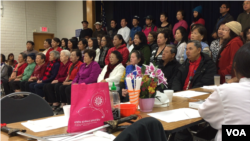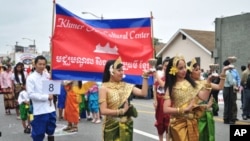At this annual commemoration for those who died during the Khmer Rouge regime, the Cambodian-American community in Long Beach, California, hope to heal past wounds.
At a commemoration ceremony on April 20, Melissa Hem, whose parents fled the regime, said “it’s beyond words.”
“Nothing you can say in a sentence sums up what it’s done to our community, our families, and our generation moving forwards; and pretty much all we can do is recognize it and heal.”
The gathering was the third organized by California Senator Ricardo Lara, Congressman Alan Lowenthal and Assemblyman Patrick O’Donnell.
“For me it was important because I also came from an immigrant background where we don’t necessary always trust the government and I want to make sure that government came to our Cambodian American community,” Lara said.
“And so now the community gets all involved in this event as you can see it’s a tremendous success and my goal is that when I leave, this event continues to flourish without me and it’s become now a point of pride for the city of Long Beach and for the Cambodian American community here.”
Participants spoke of how the Khmer Rouge regime had affected their families and the community, and ways in which people had sought healing.
O’Donnell said the gathering was “a triumph” and acknowledgment of “a tragedy”.
“That tragedy that happened so many years ago in Cambodia still lives with us in this community today,” he added. “So tonight is about acknowledging our Cambodian community, acknowledging the love we have for each other and the tragedy that the Cambodian community has suffered.”
The Khmer Rouge regime controlled Cambodia between April 17, 1975 and January 1979 and is blamed for the deaths of some 1.7 million people.
“It was an important day for our Khmer community,” said Rithy Hanh, a community member who attended the ceremony. “This is like wishing the souls of Khmers who died to live a happy life in heaven. It reminds everybody that even though they live in the US, they should not forget that time [of atrocity].”
Rithy was born on the Thai-Cambodian border after his parents fled the regime.
“It’s not too late after 42 years to get this recognition,” said Jonathan Nhean, a community activist and actor. “From now on we have to spread the word to the world about this atrocity. We should not forget or hide it because it was a cruel act that affected the whole population.”
Long Beach City Hall has allocated a plot of land for the construction of a memorial to the “killing fields”.
Many Cambodians who moved to the United States after the Khmer Rouge takeover suffer from the post-traumatic effects of conflict, according to research by Marshall and Colleagues in 2005.
“I think part of our trauma is that we feel forgotten,” said Hem, a nurse. “We’re not recognized.”
She said that there was little mention of the atrocities in Cambodia in U.S. history textbooks, despite about a third of the population having died under the regime.
“So I think having an event like this, not only helps us to be visible, but it helps to heal us as a community, bring us together and allow us to have pride and have a voice with each other.”
Lowenthal said: “To come to this country with nothing, nothing, after the genocide and now they’ve created a striving wonderful community as you can see in two generations, and three generations of Cambodian Americans in this room and I’m so proud to represent them. They are the American dream and American success story.”









